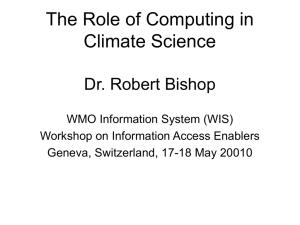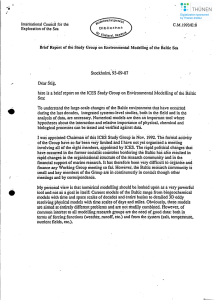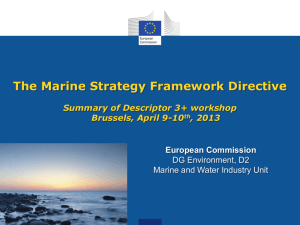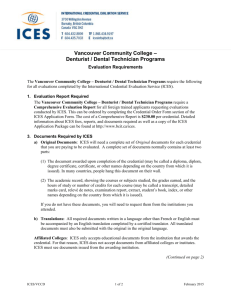International Council for CM
advertisement
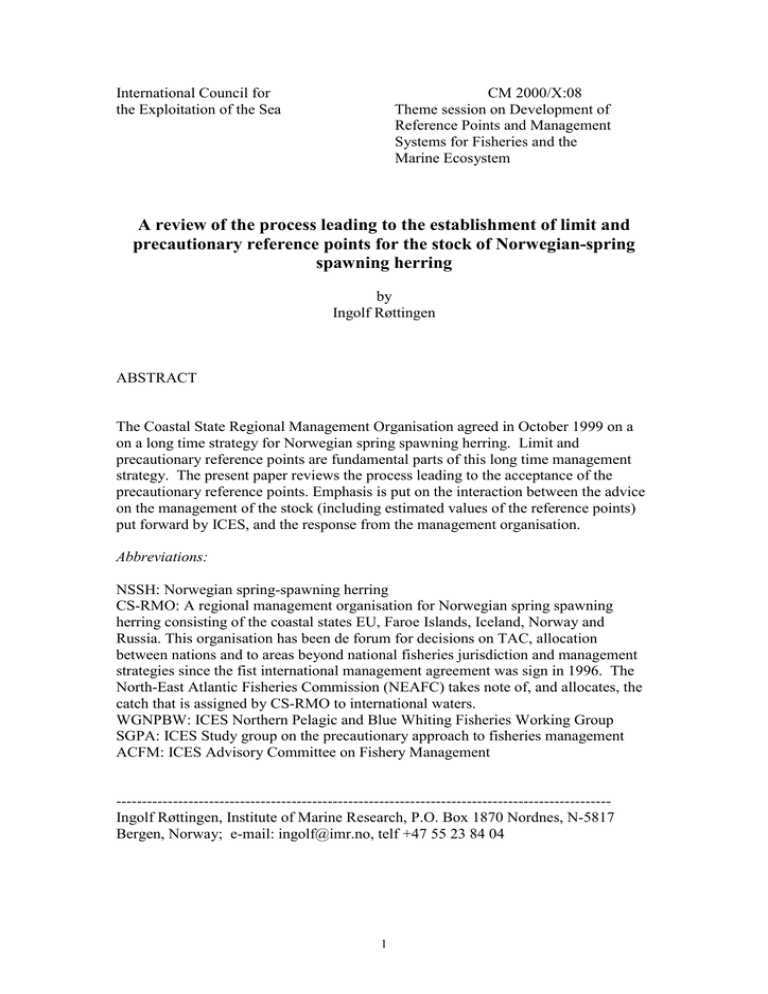
International Council for the Exploitation of the Sea CM 2000/X:08 Theme session on Development of Reference Points and Management Systems for Fisheries and the Marine Ecosystem A review of the process leading to the establishment of limit and precautionary reference points for the stock of Norwegian-spring spawning herring by Ingolf Røttingen ABSTRACT The Coastal State Regional Management Organisation agreed in October 1999 on a on a long time strategy for Norwegian spring spawning herring. Limit and precautionary reference points are fundamental parts of this long time management strategy. The present paper reviews the process leading to the acceptance of the precautionary reference points. Emphasis is put on the interaction between the advice on the management of the stock (including estimated values of the reference points) put forward by ICES, and the response from the management organisation. Abbreviations: NSSH: Norwegian spring-spawning herring CS-RMO: A regional management organisation for Norwegian spring spawning herring consisting of the coastal states EU, Faroe Islands, Iceland, Norway and Russia. This organisation has been de forum for decisions on TAC, allocation between nations and to areas beyond national fisheries jurisdiction and management strategies since the fist international management agreement was sign in 1996. The North-East Atlantic Fisheries Commission (NEAFC) takes note of, and allocates, the catch that is assigned by CS-RMO to international waters. WGNPBW: ICES Northern Pelagic and Blue Whiting Fisheries Working Group SGPA: ICES Study group on the precautionary approach to fisheries management ACFM: ICES Advisory Committee on Fishery Management -----------------------------------------------------------------------------------------------Ingolf Røttingen, Institute of Marine Research, P.O. Box 1870 Nordnes, N-5817 Bergen, Norway; e-mail: ingolf@imr.no, telf +47 55 23 84 04 1 INTRODUCTION In October 1999 CS-RMO agreed on a long time management strategy for NSSH consisting of 4 paragraphs. The paragraphs were: 1. Every effort shall be made to maintain a level of Spawning Stock Biomass (SSB) greater than the critical level (Blim) of 2 500 000 tonnes. 2. For the year 2001 and subsequent years, the Parties agreed to restrict their fishing on the basis of a TAC consistent with a fishing mortality rate of less than 0.125 for appropriate age groups as defined by ICES, unless future scientific advice requires modifications of this fishing mortality rate. 3. Should the SSB fall below a reference points of 5 000 000 tonnes (Bpa), the fishing mortality rate, referred to under paragraph 2, shall be adapted in the light of scientific estimates of the conditions then prevailing. Such adaptions shall ensure a safe and rapid recovery of the SSB to a level in excess of 5 000 000 tonnes. 4. The parties shall, as appropriate, review and revise these management measures and strategies on the basis of any new advice provided by ICES. As can be seen, reference points (Blim and Bpa) form an important element in the long time strategy for NSSH. The choice of a precautionary fishing mortality rate (Fpa) is not explicitly stated in the management plan, but it refers to a maximum fishing mortality rate of 0.125. It should be noted that there is no catch ceiling in the management plan. The present paper will give an account on the evolution and rationale behind the absolute values of these reference points and maximum fishing mortality REFERERCE POINTS Blim: The limit spawning stock biomass The beginning of the 1970ies saw a stock collapse of NSSH which 15-20 years earlier had a spawning stock in access of 10 million tonnes (Dragesund et al 1980, ICES 2000a). This stock collapse occurred rapidly, from a record catch of 2 million tonnes in 1966, to a collapse and zero catch some 5-6 year later. The reasons for the collapse were many, but an important element was the lack of international agreements on limits and allocations of the catch and fishing effort. This former large straddling stock was reduced to a small stock that spent the entire year in Norwegian waters. The stock collapse had a very fundamental and negative experience for the countries that had carried out this important fishery. This was seen as an experience that should under no experience be repeated. On the basis of this it should be clear that avoiding a spawning stock level that implied probable recruitment failure should be a management objective of high priority. The Norwegian management authorities decided on strategy was set to rebuild the spawning stock to at least 2.5 million tonnes before a regular fishery could be opened. In the rebuilding period the maximum fishing mortality was in practice set to 0.05. The rebuilding level 2 (also termed target level) of 2.5 million t was set on basis of a stock-recruitment plot, constructed from results from the first VPA analysis of this stock (Dragesund and Ulltang 1975). These regulation measures were eventually accepted by the fishing industry. In 1991 ICES adopted a new approach to formulating its new advice. (Serchuk and Grainger 1992). The objective was formulated to be “To provide the advice necessary to maintain viable fisheries within sustainable ecosystems”. The “minimum biologically acceptable level” (MBAL) became an important element. The most common definition of MBAL was probably a level of the spawning stock below which the data indicate that the probability of poor recruitment increases as spawning stock decreases. In essence this was a similar thinking to the rebuilding or target level that already had been accepted in the management of the NSSH, and MBAL was consequently set to 2.5 million t. From 1997-98 the ICES advice has been given in a form that provides for a precautionary advice to fisheries management. In this process the setting of the limit and precautionary reference point was important. Both the SGPA (ICES 1998a) and WGNPBW (ICES 1998b) suggested that this biomass limit reference point for this stock should be set to 2.5 million t. The most common definition of Blim seem to be that this is the level below which recruitment is impaired, or there is a high probability of low recruitment (ICES 2000b). This definition corresponds to the philosophy used in setting earlier reference points for NSSH such as rebuilding aim and target stock. The first stock recruitment analysis indicating this was made about 25 years ago. Has information obtained since 1975 changed the general view? This information tells us that we have had a spawning stock of less than 2.5 million t in 18 years since 1970, in 17 of these years the resulting year classes have been poor (ICES 2000a). (The exception is 1983 where a good year class was obtained from a spawning stock of about 0.5 million t). This information seems to support the earlier assumption that the recruitment can be impaired when the spawning stock is lower that 2.5 million t. In the 12 years where the spawning stock has be greater than 2.5 million tonnes in the same period have resulted in 2 strong year classes (1991 and 1992), 3-4 years with a “average” recruitment, i.e. year classes 1989,1990,1993 and 1998), altogether a much more satisfactory recruitment. This seems to support the decision for setting the Blim a level of 2.5 million tonnes. (However, the spawning stock size is not the only relevant factor in the recruitment process of NSSH, the environmental factor also probably play an important role). Summary: The main factor determining the Blim to 2.5 million tonnes for NSSH must be seen as a spawning stock threshold that, if crossed, can result in a high probability of impaired recruitment. However, elements such as earlier management acceptance of biological reference points (rebuilding level and MBAL), which corresponds to the same level, are also included in the consideration of the Blim- level. 3 Bpa: The precautionary biomass. In the case of NSSH the SGPA stated in 1998: “No Bpa or Flim are suggested. Since this is a stock, which is dominated by a few outstanding year classes, management discussions have concentrated on how fast it is advisable to deplete the present year classes, rather than on harvest control rules that require a certain Bpa as trigger for special actions (ICES 1998a). However, one of the guidelines for determining Bpa has been a level where there is “Unacceptable probability that the stock is actually below Blim when it is measured at Bpa” (ICES 2000b). In line with this the WGNPBW stated in 1998: “Spawning stock biomass values calculated in assessments made since 1990 in the Assessment Quality Control Diagram indicated that a CV of 0.4 would be appropriate for this stock. Applying the relation Bpa = Blim*exp (sigma*1.645) (ICES 1998a) gives a Bpa of approximately 5 million t. And this was followed up by ACFM: In order to take into account uncertainty in estimating biomass, a Bpa of 5.0 million tonnes is proposed (ICES 1999a). These indications of appropriate CV levels do not have sound statistical procedures as basis, this number was based on the subjective feeling for the uncertainty generated by the large deviation among assessments made with different assumptions and from retrospective analyses. A bootstrap analysis can bring the CV estimates more in line with formal statistical procedures. This will be further investigated by the WGNPBW: “The WG failed at the meeting (in 2000) to produce a new uncertainty analysis of the estimate based on bootstrapping due to time constraints and lack of adequate computing power. The CV for the spawning stock calculated from bootstrapping only survey data is 0.17. If the uncertainty in the estimate represented by the uncertainty in the surveys is not small compared to the uncertainty in tagging and catch, the WG feels that a CV of 0.4 used in the previous WG meeting might be to high.” (ICES 2000a) Summary. The Bpa of 5.0 million t for NSSH is regarded as a safeguarding level in order to avoid actually being at the Blim-level when measuring spawning stock at Bpa. The technical statistical basis for the estimation of this level will probably be improved in the future. Flim: The limit fishing mortality This reference point has not been considered useful or relevant for the management of NSSH (ICES 1998a and 1998b). This is due to the NSSH-recruitment dynamics with few occasionally very strong year classes. Fpa: The precautionary fishing mortality For many stocks the basis for Fpa is linked to Flim in the sense that the Fpa is designed to ensure that there is a high probability that Flim will be avoided. (ICES 2000b). From the above paragraph it can be concluded that this concept of estimating Fpa cannot be applied to NSSH. 4 The mid-1990s were very important for the stock of NSSH. The stock exceeded the target spawning stock level (2.5 million t). The fishery expanded from the rebuilding levels managed by a fishing mortality of less than 0.5, to an “ordinary level”. Thus a new management strategy had to be developed. Further, the stock appeared in waters outside the Norwegian EEZ, and international agreements had to be agreed upon. Although the WGNPBW started with the medium term simulations in 1994 (ICES 1995) it was in 1996 the medium term simulations became a relevant element in the advisory process (Bogstad et al. 2000). In the ACFM report for May 1996 on the advice on NSSH for 1997 it is stated: “ICES advises that the fishery on this stock should be managed to ensure that the SSB is kept above the MBAL of 2.5 million t.” The paragraph on Medium-term considerations in the same ACFM report reads as follows: “…Due to weak year classes the spawning stock is expected to decrease in the medium term. The development indicated by medium-term simulations strongly depends on the stock-recruitment model chosen for the simulations and the management regime implemented. It is difficult to construct appropriate recruitment models for the stock, which is characterised by occasional very large year classes and extended periods of low recruitment. Preliminary medium-term simulations indicate that a management regime implementing a combination of a maximum fishing mortality level of 0.15 and a catch ceiling of 1,500,000 t will lead to a low probability of the stock falling below the minimum acceptable level (MBAL) before the year 2006, while either of these measures in isolation will lead to a considerable risk of SSB falling below MBAL.” (ICES 1997). In December 1996 the CS-RMO agreed on a TAC for 1997 of 1.5 million t. The basis for this decision was the suggested management regime implementing a combination of a maximum fishing mortality level of 0.15 and a catch ceiling of 1.5 million t referred to in the ACFM May 1996 report. This fishing mortality and catch ceiling remained the basis for the ICES advice in the period 1996-2000. The original intention of this strategy was, with a high probability, to keep the stock above 2.5 million t, and the strategy did not then include other elements such as stability of catches or compliance to the precautionary approach. SGPA seems to have adopted this reasoning when they in 1998 suggested for NSSH a “Fpa =0.15, indicated by medium term simulations and adopted by the Working Group, together with a catch constraint of 1.5 million t. “ (ICES 1998a). However, other elements have also, as background information, contributed to the choice of Fpa of 0.15. These are arguments in a more in line with growth overfishing reasoning. In addition to the medium-term considerations, WGNPBW has made some preliminary long-term simulations of the stock of NSSH with stochastic recruitments over long time periods (ICES 1996). The runs were made with two types of stockrecruitment functions. Simulation with constant F indicate that the average yearly yield has its maximum in the range of F= 0.13-0.15 which coincided with the value used for the natural mortality of this stock (M=0.15). Both recruitment models showed this, but at somewhat different models of average yields. The runs were of a preliminary nature, and the recruitment functions applied to not exactly correspond to the recruitment function that is applied in the medium term at present. However, they indicate that the fishing mortality in the order of 0.13- 0.15 can be viewed as a form of optimum long-term yield level. 5 Summary: A value of 0.15 for Fpa has a complex origin. From the above it made be concluded that the original “technical base” for Fpa =0.15 for NSSH is an unacceptable probability that SSB might fall below Blim (or MBAL as this level was referred to in 1996) in the medium term. There may also be included MSY considerations and the fact that this fishing mortality had a tradition as a constraint for advice from ICES. It is importation to take note of that the Fpa value is originally linked to an operationally catch ceiling of 1.5 million t (ICES 1998a). RESPONSE FROM CS-RMO Fpa = 0.125 or 0.15? The discussion on the maximum fishing mortality to place on the annual meeting of CS-RM in October 1999. An important management objective is to avoid a stock collapse, or in a precautionary approach context, to avoid the spawning stock from getting below Blim 2.5 million t. In the medium-term simulations made by WGPNBW in the later years, using F=0.15 and a catch ceiling of 0.15, the risk for reaching Blim in the medium term has been as follows: WGPNBW 1998: WGPNBW 1999: WGPNBW 2000: 21% (ICES 1998b) 19% (ICES 1999b) 14% (ICES 2000a) The mean reasons for these variations has been revisions of adult stock estimates and estimates of new year classes that have changed from being estimated from the stock recruitment relations to results from surveys. It is of course difficult to interpret these risk estimates absolutely, they indicate that the risk of reaching Blim within a 10 year period is in the order of 10-20%. Is this a low or high risk? CS-RMO may have, in light of the important management objective of keeping the stock above Blim, regarded this risk as being to high, since they have set the maximum fishing mortality in the long time management plan to 0.125. (Bogstad et al 2000). This maximum fishing mortality is below the Fpa value suggested by ACFM (Fpa=0.15) and on which the advice from ICES has been constrained. ACFM has stated: ”The difference between the limit and the precautionary approach reference points is also related to the degree of risk the fishery management agencies are willing to accept. Therefore, although ICES sees its responsibility to identify limit reference points, it will suggest precautionary reference points. The adoption of precautionary reference points requires discussion with fishery management agencies.” (ICES 1999a). A discussion on precautionary reference points has taken place in CS-RMO, resulting in a maximum fishing mortality of 0.125 in the agreed long time management strategy. Should then ACFM at its May 2000 meeting revise its proposal of Fpa from 0.15 to 0.125? Should the ICES advice be constrained by 0.125 or 0.15? The answer from the ACFM May 2000 meeting seems to be along the following line: “If the management agencies choose to be more cautious than the Fpa suggested by ACFM, this will be acknowledged and view as a positive step in the management of the stock. However, ACFM will not change its proposal of Fpa unless there are radical changes in view of the situation of the stock as seen from medium term simulations or other data“. There does not seem to have been a discussion in 6 ACFM, as was the case in CS-RMO, on the estimates for the risk if crossing the Blim (in the range of 21 to 14%) can be termed “low probability of leaving the spawning stock below Blim within 10 years.” The advice from ICES on NSSH in May 2000 was on the basis of F=0.125: “ICES advices that this fishery should be managed according to the agreed management plan corresponding to a catch of 753 000 t in 2001.” In the management option table this catch is given with “adopted by management” as basis. However, in the same table the catch option for F=0.15 is also given as a “non-shaded” option (894 000 t) with Fpa as a basis. REFERENCES Bogstad, B., Røttingen, I., Sandberg, P. and Tjelmeland, S. 2000. The use of Medium-Term Forecasts in advice and management decisions for the stock of Norwegian spring-spawning herring. ICES CM 2000/V:01. 8pp. Dragesund, O. and Ulltang, U. 1975. Stock size fluctuations and rate of exploitation of the Norwegian spring-spawning herring 1950-1974. ICES CM 1975/H:47. 27pp. Dragesund, O., Hamre, J. and Ulltang, Ø. 1980. Biology and population dynamics of the Norwegian spring-spawning herring. Rapp.P.-v.Reun.Cons.int.Explor.Mer, 177. ICES 1995. Report of the Atlanto-Scandian herring, Capelin and Blue Whiting Assessment Working Group. Copenhagen, October 1994. ICES CM 1996/Assess:9. 150pp. ICES 1996: Report of the Northern Pelagic and Blue Whiting Fisheries Working Group. Bergen, April 1996. ICES CM 1996/ACFM 14: 158pp ICES 1997. Report of the ICES Advisory Committee on Fishery Management 1996 ICES Coop. Res.Rep.No.223. ICES 1998a. Report of the study group on the precautionary approach to fisheries management, February 1998. ICES CM 1998/ACFM:10. 36pp. ICES 1998b: Report of the Northern Pelagic and Blue Whiting Fisheries Working Group. Copenhagen, April 1998. ICES CM 1998/ACFM 18: 276pp ICES 1999a. Report of the ICES Advisory Committee on Fishery Management 1998 ICES Coop. Res.Rep.No.229. ICES 1999b: Report of the Northern Pelagic and Blue Whiting Fisheries Working Group. Copenhagen, April 1999. ICES CM 1999/ACFM 18: 238pp ICES 2000a. Report of the Northern Pelagic and Blue Whiting Fisheries Working Group. Copenhagen, April 2000. ICES CM 2000/ACFM:16. 226pp. ICES 2000b. Report of the CWP intersessional meeting, February 2000. ICES CM2000/ACFM :17. Serchuk, F.M. and Grainger, R.J.R. 1992. Development of the basis and form of ICES Fisheries Management Advice. ICES CM 1992/Assess: 20. 8pp. 7
